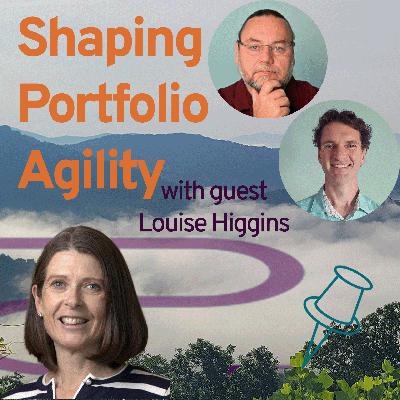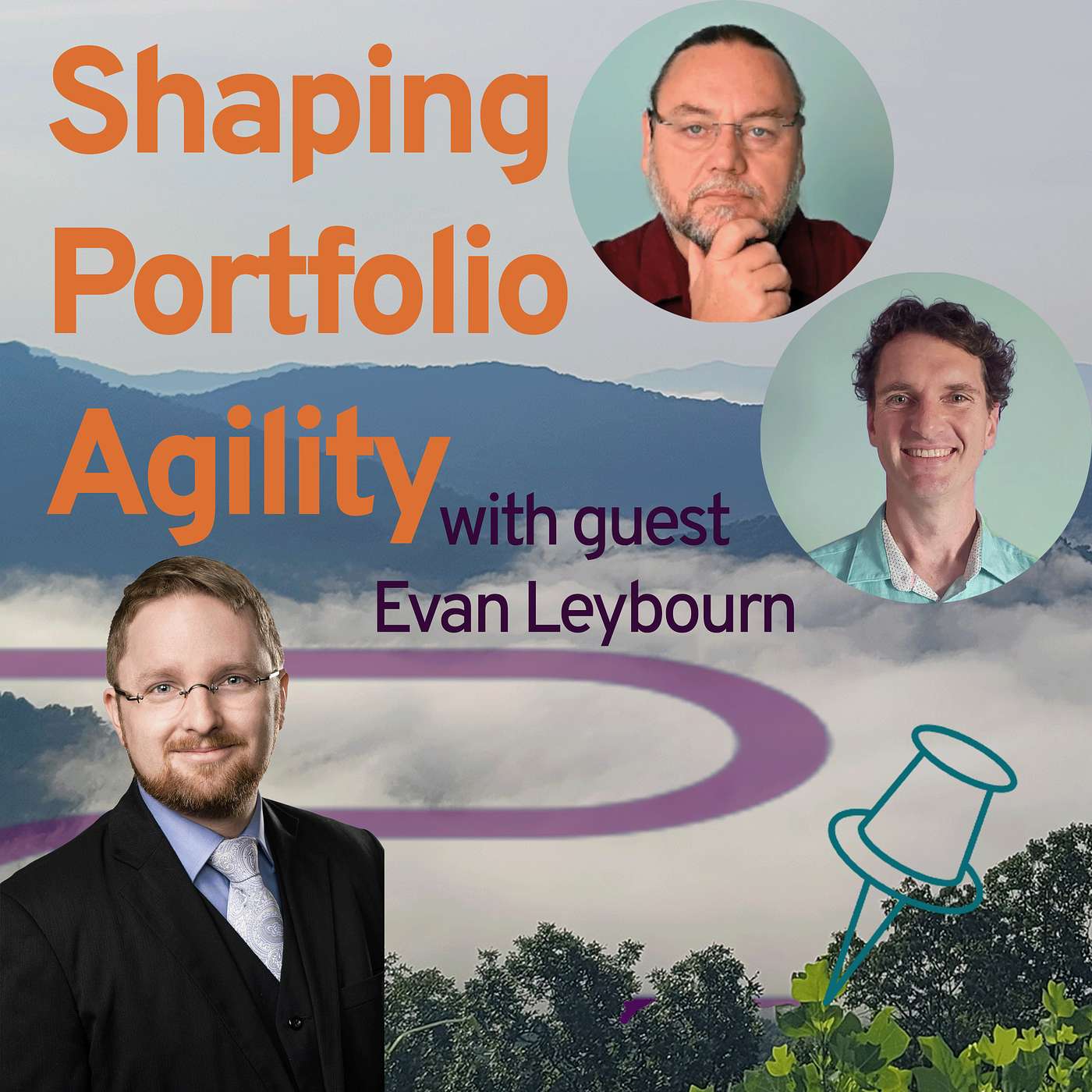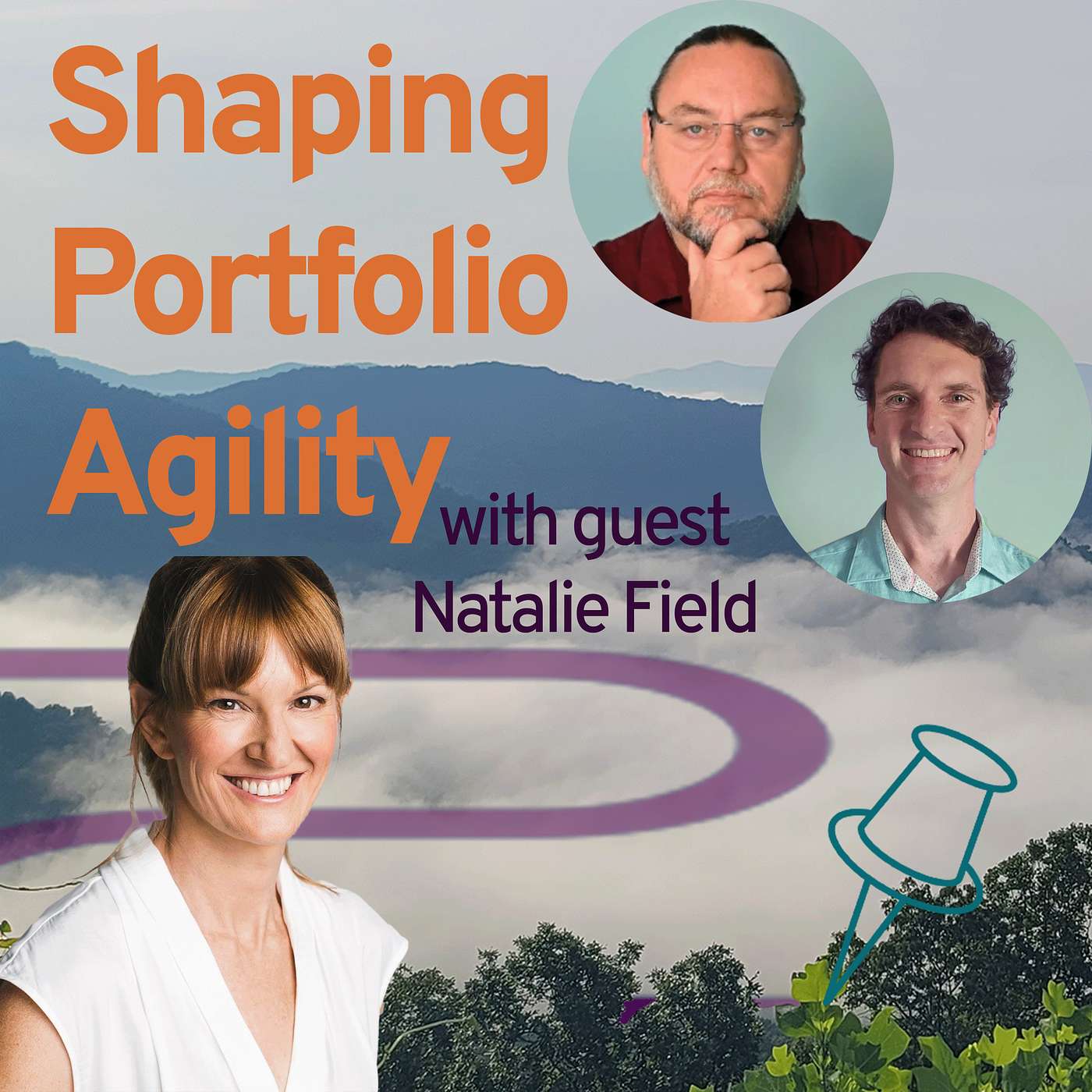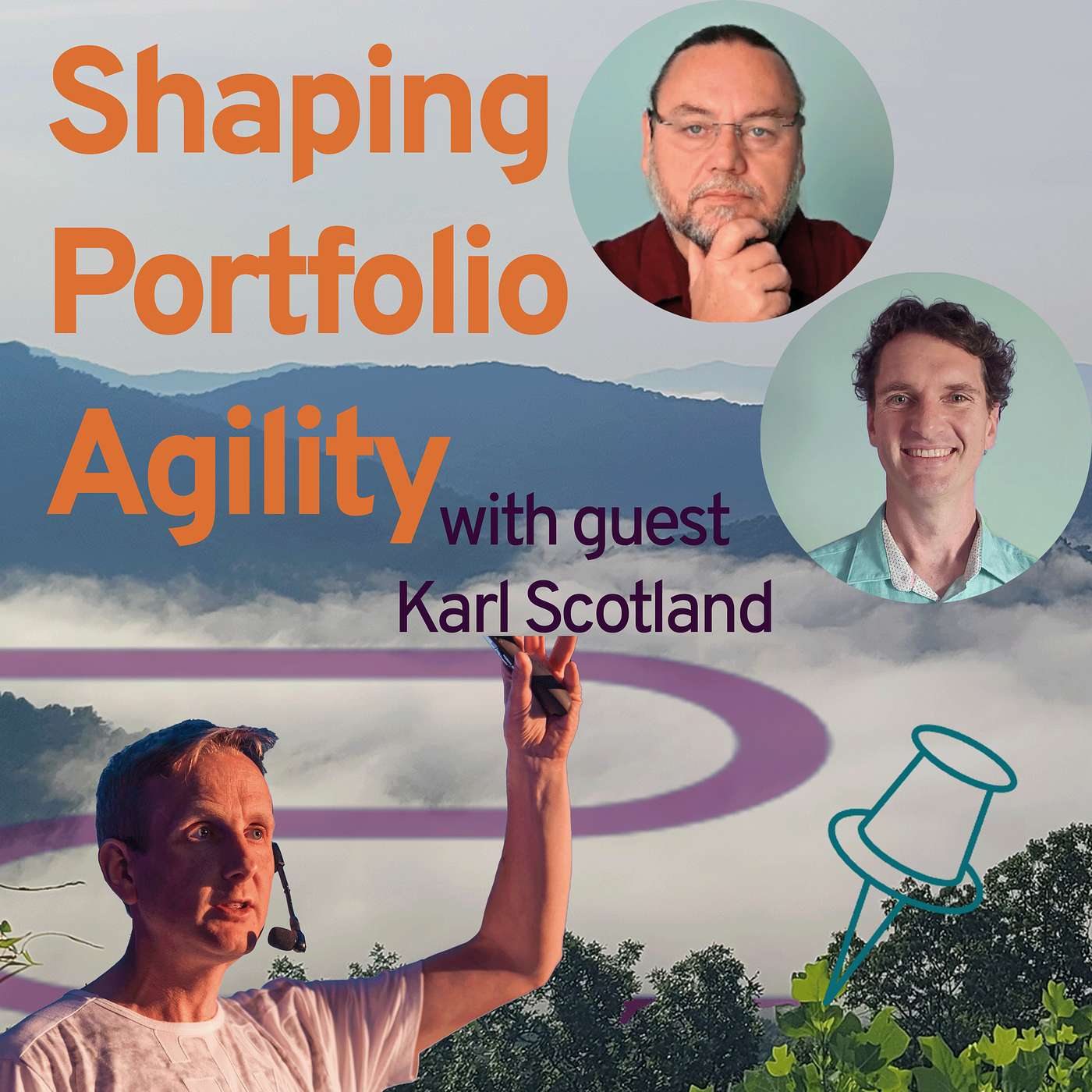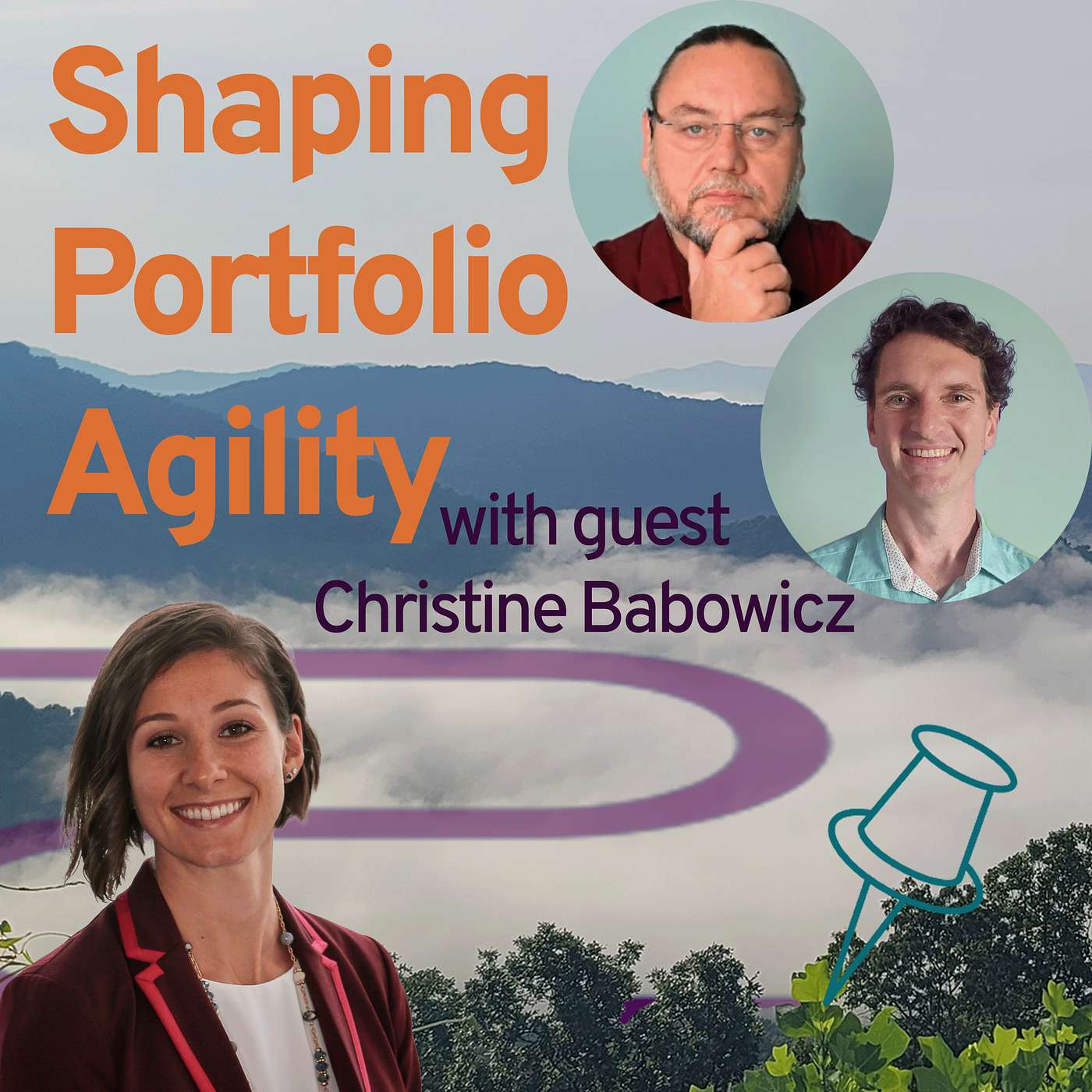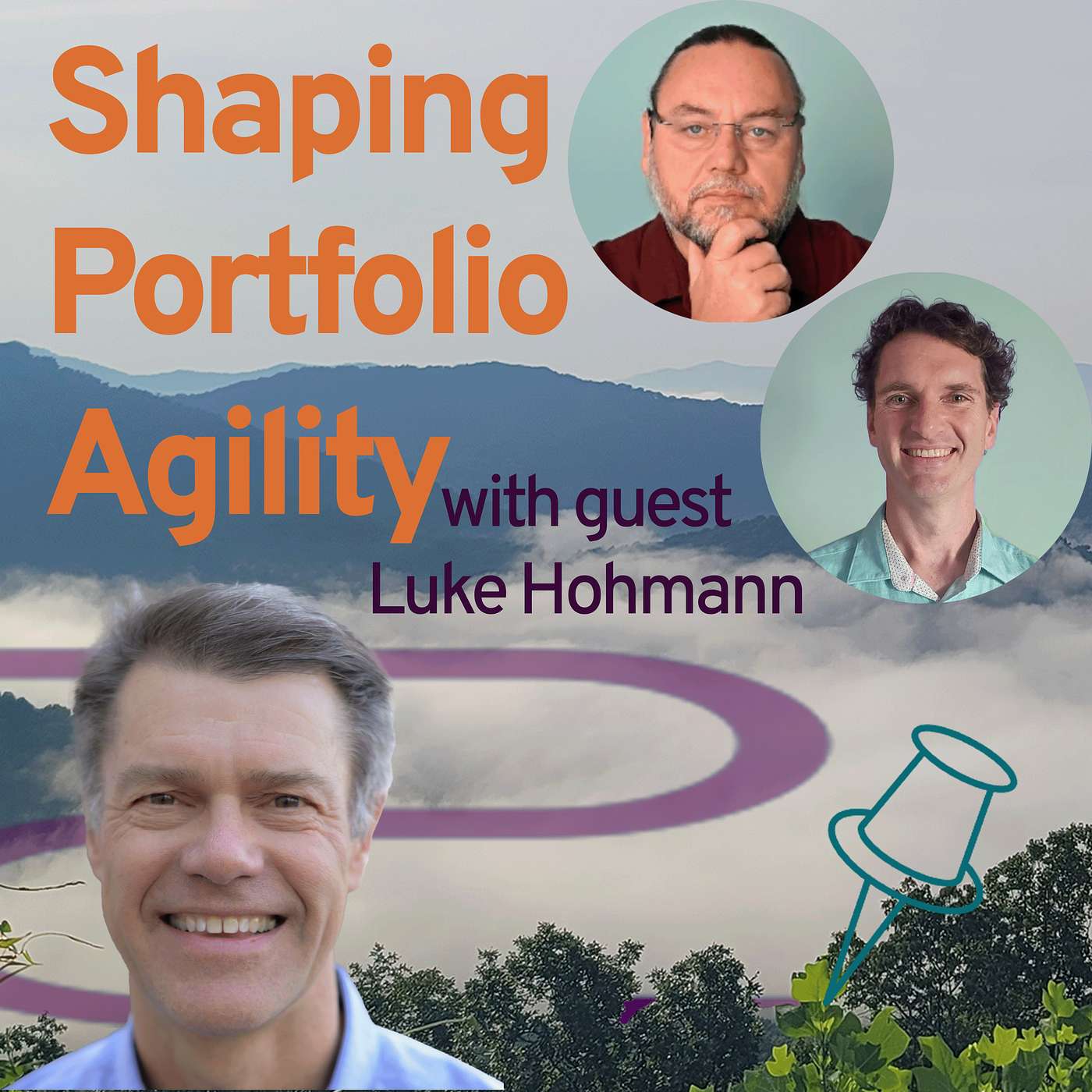Discover Shaping Portfolio Agility
Shaping Portfolio Agility

Shaping Portfolio Agility
Author: Eric Willeke, Mark Richards
Subscribed: 1Played: 2Subscribe
Share
© 2025 Shaping Agility
Description
For portfolio leaders and the shapers who serve them who want to increase the effectiveness and impact of their portfolio management approaches, Shaping Portfolio Agility is a podcast hosted by SAFe Fellows Mark Richards and Eric Willeke. It helps portfolio leaders expand their mindset towards lean portfolio management.The show kicks off with a seven-podcast arc covering our key mindsets on portfolios, how they fit in an ecosystem, and how they shape and respond to enterprise strategy. It continues with guest appearances from thought leaders and portfolio leaders. The show does not attempt to ”teach” LPM as a structured series of lessons. Rather, it is shaped to inspire healthy mindsets and approaches for growth.
14 Episodes
Reverse
“You have to respect the orthodoxy of the culture that you’re operating within, because it will absolutely hold the way in which things are done. And you will know when you come up against that culture—you will feel it.” - Louise Higgins
----
In this episode, we’re joined by Louise (Lou) Higgins. Lou joined ANZ in January 2020 as the Chief Financial Officer of Technology and Enablement. She was appointed Chief Financial Officer of Australia in May 2021 and Managing Director of Suncorp Integration in September 2022. In September 2023, she was appointed to lead the Australia Retail Strategic Delivery function in conjunction with her Suncorp Integration responsibilities until February 2024. Lou currently leads the Strategy and Transformation for the Australian retail business.
In this role, Lou partners closely with the Group Executive, Australia Retail, and the Australia Retail leadership team to deliver a significant and complex transformation and prepare the business for the future.
Lou has a diverse set of skills and experience, having worked across multiple industries during her 20+-year career. She commenced her executive career in London before relocating back to Australia to work as an associate director with Macquarie Bank. In 2010, she became the Chief Operating Officer for Nova Entertainment. In January 2017, Lou was appointed Chief Financial and strategy Officer for the Australian Broadcast Corporation (ABC), where she oversaw the design and implementation of a significant technology transformation of the broadcaster.
Lou also has a diverse Non-Executive Career, having worked for Commercial Radio Australia, Visit Victoria, Qudos Bank, Canteen Australia, OneTwo Finance, and Enero Group Limited.
Our conversation with Lou explores the intricate dynamics of leadership and cultural transformation, set against the backdrop of her recent work leading the strategic Suncorp acquisition. Her candid insights reveal the importance of empathy, self-awareness, and strategic alignment in driving successful change.
She reminds us that effective leadership isn’t just about achieving outcomes—it's about how we lead others to those outcomes.
In this episode, we cover:
(00:00) Introduction
(06:15) Why do you think effective partnerships between finance and technology are so rare?
(11:39) What do you mean by the word transformation?
(15:18) How do you hold the tension between transforming the business and keeping it functioning while you do it?
(21:29) What stood out to you when you travelled the world studying banking acquisitions?
(29:49) How do you balance between knowing the whole answer yourself and slowly finding the answer together?
(35:19) What are some of the tools you use to paint the future for your people?
(41:47) How do you encourage the people that work for you?
(46:53) What’s the role of likeability in leadership?
(53:39) How do you navigate the clash of cultures during an integration?
(56:57) How do you deliver hard messages about the need for change as a leader?
(59:03) What’s the one piece of advice you’d give others approaching significant transformations?
“Just as delegation is a skill that can get taught to leaders and often is, the ability to take ownership is a skill that needs to be developed in people, and organizations often do not invest in training that.” - Evan Leybourn
In this episode, we are joined by Evan Leybourn, the founder and CEO of the Business Agility Institute. Evan has been a thought leader in the realm of Business Agility since 2008, advocating for organizations to rethink how they operate, lead, and govern to become more human-centric and adaptable in the face of constant change.
Evan's journey began with a realization that organizations needed to move beyond traditional agile practices confined to IT and software development. In 2016, he established the Business Agility Institute, aiming to create a global community dedicated to redefining business structures and cultures. The Institute has since become a hub for research, thought leadership, and collaboration among professionals striving to transform their organizations.
During our conversation, Evan delves into the fundamental differences between agile and Business Agility, emphasizing that Business Agility extends beyond methodologies to encompass organizational behaviors and mindsets. He shares insights from recent research studies conducted by the Institute, including "Bridging the Divide" and "The Balancing Act," which explore the challenges organizations face in collaboration, prioritization, and leadership.
Evan discusses the decline in organizational collaboration observed between 2022 and 2023, attributing it to factors like fear-based leadership and siloed structures exacerbated by economic uncertainties. He highlights the importance of moving towards human-centric governance and leadership models to foster organizational resilience and unity.
Through candid reflections, Evan offers valuable advice on breaking down silos, aligning goals, and investing in leadership development. He underscores organizations' need to build the muscles required to respond effectively to change, no matter how unexpected.
In this episode, we cover:
(00:00) Introduction
(04:07) What led to the founding of the Business Agility Institute?
(10:15) What differentiates Business Agility from agile?
(17:20) What emerged from the institute’s recent research study on trends in organizational collaboration?
(24:40) What did the onset of the pandemic teach us about organizational agility?
(33:24) What did the “Balancing Act” study on prioritizaton reveal?
(39:50) What lies behind the struggle to act on the gap between supply and demand for strategic capacity?
(45:30) What’s the secret to sustainable change?
(52:21) How do leaders create time for change?
Throughout the episode, Evan emphasizes that change is inevitable and constant. Organizations that proactively develop the capabilities to adapt and respond to change are better positioned to achieve their purpose and succeed in today's dynamic environment.
Cast:
Evan Leybourn
Eric Willeke
Mark Richards
References:
Good to Great - Jim Collins
Reinventing Organizations - Frederic Laloux
Integral Theory - Ken Wilber
Switch - Chip and Dan Heath
The Principles of Scientific Management - Frederick Winslow Taylor
Crucial Influence: Joseph Grenny et al
“Often, there’s a real lack of clarity about where we are now. And it can be a very uncomfortable, painful set of truths that people don’t want to face. But to create progress, you need to face uncomfortable truths and understand where you’re starting from." - Natalie Field
In this episode, we’re joined by Natalie Field. Nat recently commenced as CEO of Informed Decisions and has accrued a wealth of portfolio leadership experience over the course of her career. Highlights include serving as the Chief Digital and Data Officer for BUPA Asia Pacific, Chief Technology Officer at Belong, and General Manager of the digital portfolio at Australia Post.
Nat is a customer-centric leader with 20 years of global experience in innovation, customer, product, digital, data, and technology. A catalyst for change, she has worked across multiple industries, including health, telecommunications, and services. She has a proven track record of leveraging digital, data, and technology to increase the impact of existing business models and unlock new growth opportunities.
She is recognized for her ability to work across organizational silos to create an ambitious vision and bring that vision to life in a way that creates customer and commercial growth while focusing on operational excellence.
Her passion for leadership and accessing excellence in others is combined with a fierce determination to exceed expectations.
During our conversation, Nat delves into the realities of leading large portfolios and navigating executive roles. She shares hard-won lessons about balancing quick wins with long-term vision, building outstanding leadership teams, tapping into their strengths, and using metrics to drive strategic outcomes. Through candid reflections, Nat offers valuable advice on creating clarity, building resilient teams, and managing the delicate balance between purpose and progress. Her approach to leadership is shaped by a clear focus on empathy, transparency, and aligning people with purpose.
In this episode, we cover:
(00:00) Introduction
(04:02) Where do you focus first when you take on a new portfolio?
(10:15) Why try to bring the biggest naysayers closer?
(13:46) How do you balance the tension between sustainable change and rapid results?
(19:43) What role do you feel metrics play in strategy?
(27:31) What about purpose?
(35:58) What stereotypes did you have about the role of a CEO back when you didn’t have it?
(43:03) What’s the secret to sustaining energy for the vision in the face of day-to-day reality as a leader?
(46:58) How do you pick your advisors?
(51:31) Can you provide an example of using a strengths finder to inform your leadership approach?
References:
Good to Great - Jim Collins
The Five Dysfunctions of a Team - Patrick Lencioni
Reality is Broken - Jane McGonigal
The Power of Full Engagement - Jim Loehr and Tony Schwartz
Gallup StrengthsFinder
"Real strategy deployment empowers teams to act on strategic intent with ownership and clarity." - Karl Scotland
We’re joined by Strategy Deployment expert Karl Scotland in this episode.
Karl helps businesses become Learning Organisations through outcome-oriented, continuous transformation, engaging everyone, everywhere.
Over the last 20+ years, he has been an advocate of Lean and Agile approaches to achieve this, working with companies including the BBC, Yahoo!, EMC Consulting, Rally Software, Cisco, SDL, Legal & General, Allegis, HSBC, Bank of America, Vocalink, Sky, and Irwin Mitchel.
During this time, he has been an early adopter of XP and Scrum, a contributor to Agendashift, and a pioneer of using Kanban Systems and Strategy Deployment for product development. He is a founding member of both the Lean Systems Society and Limited WIP Society, active in the Lean and Agile community, and a regular conference speaker. As a result, he was awarded the honorary Brickell Key Community Contribution Award at the 2013 Lean Kanban North America conference.
Our conversation explores Karl’s journey with Strategy Deployment, particularly how he learned and applied it during his time at Rally Software. He explains how models like the X-Matrix help to align aspirations, strategies, and tactics by visualizing and connect strategic decisions to tangible actions. Karl emphasizes that strategy deployment is a continuous, evolving process that requires ongoing feedback and adaptation rather than a static plan. He shares how using Strategy Deployment at Rally fostered collaboration, benefited from customer involvement in strategic planning, and enabled the organization to make more informed decisions about what to prioritize and what to stop doing.
Karl also introduces us to the “TASTE” model he has developed as a framing model for understanding the state of a group’s strategy deployment:
(T)rue North - What direction are we trying to head in?
(A)spirations - How are we defining success?
(S)trategy - How are we going to get there?
(T)actics - What are we actually going to do?
(E)vidence - What leading metrics will indicate whether we’re making progress?
In this episode, we cover:
(00:00) Introduction
(08:05) What led you to Strategy Deployment?
(15:42) What is the connection between Strategy Deployment and Big Room Planning?
(30:45) What happened when you brought real customers into your strategic planning events?
(38:52) How would you describe the difference between Strategy Deployment and Participatory Budgeting?
(48:20) What is the thinking behind ‘acting in the present?’
(54:20) What advice would you give someone starting their Strategy Deployment journey?
Cast:
Karl Scotland
Eric Willeke
Mark Richards
References:
Karl's Blog
Hoshin Kanri for the Lean Enterprise - Thomas Jackson
The Art of Action - Stephan Bungay
Good Strategy Bad Strategy - Richard Rumelt
"So on any given day, I'm just managing those planes and flight patterns and trying to make sense and create that sequencing of road maps. Or at least highlight, hey, you're not going to achieve that, because this strategy over here in this portfolio isn't even thinking that way” - Christine Babowicz
When we decided to start inviting guests to join us, we were passionate about finding people with real lived experience to share their hard-won insights and wisdom. We were very grateful when Christine Babowicz agreed to join us as our second guest, and she certainly brought plenty of wisdom.
Christine currently serves as Head of Global Execution Excellence at MetLife. She joined MetLife almost nine years ago after spending time at Intel and Adesa. Initially serving in a PMO capacity, she became involved in the launch of MetLife’s Global Lean-Agile CoE 6 years ago. It quickly became a pull-based global agility and ways of working transformation.
Her role has recently expanded into partnering with Enterprise Strategy and 16 portfolios across MetLife to bring their AI strategy to life, focused on creating differentiated experiences for their associates and customers.
Over the years, she's spoken at various Agile Conferences and SAFe Summits, and her topics show her passion for leadership empathy during times of change. She was also a founding member of Raleigh-Durham Women in Agile. Recently, her leadership style and transformation efforts have earned her the Triangle’s Business Journal 40under40 award.
Our conversation takes us through her journey as a change leader over the past six years. Christine shares the challenges of forming an Agile PMO amidst established practices and how her background in lean thinking shaped her approach. We discuss the importance of translating between old and new methodologies, building empathy and trust with stakeholders, and focusing on the problems portfolio leaders face rather than the solutions the textbook provides. She also shares the value of grounding conversations across portfolio boundaries in the organizational mission and a deep understanding of business processes.
As a leader, she highlights the privilege of these transformative roles and the importance of staying humble and prepared when navigating such complex landscapes.
In this episode, we cover:
(00:00) Introduction
(05:44) What was it like forming an agile PMO in the middle of a very project-centric world?
(11:01) How do you navigate the translation between the old and new worlds?
(15:21) What triggered your transition to portfolio?
(21:03) With 16 portfolios, how did you pick where to start?
(24:50) What was your first step once you found your leverage point?
(30:08) What’s critical for a coach trying to connect with portfolio-level leadership?
(35:27) What secrets have you found to enabling change across portfolio boundaries?
(39:56) As a change leader, how do you make it safe for your team to tackle challenging conversations?
(47:28) Have you found recurring patterns that enable scaling of your change efforts?
(52:46) How do you help leaders balance aspiration and obligation?
(59:52) What parting wisdom would you share?
Cast:
Christine Babowicz
Eric Willeke
Mark Richards
“The right collective organization tends to have fewer blind spots, because, by definition, a team is a transactional memory system of sufficient predictive power that we can know how to work together” - Luke Hohmann
When we decided to start inviting interesting guests to join our portfolio conversations, Luke Hohmann was an obvious first choice.
Luke is a four time author, three time founder, SAFe® Fellow, keynote speaker, and internationally recognized expert in Agile Software Development. His passion is sustainably profitable businesses, because it is only through sustainable profits that a business can thrive.
As Chief Innovation Officer of Applied Frameworks he works with executives to fulfill their mission of helping our customers create sustainably profitable businesses. His most recent book, Software Profit Streams™: Designing Sustainably Profitable Businesses , is co-authored with Jason Tanner and shares key insights from their experience helping businesses succeed.
He co-founded Every Voice Engaged, a nonpartisan 501c3 nonprofit that helps citizens, governments, and nonprofits collaboratively solve unsolvable problems. He founded Conteneo, creator of Weave, the Strategy Engine, and Knowsy, later acquired by Scaled Agile Inc.
Our conversation blends deep insights with practical advice. Luke shares stories from his extensive experience, discussing how to start a Lean Portfolio Management journey by understanding and improving existing practices rather than introducing entirely new ones. He emphasizes the importance of having the right people at the portfolio table, including often-overlooked roles like finance and HR, to ensure a balanced and holistic approach.
Luke also delves into the cognitive challenges leaders face in balancing long-term strategy with immediate operational demands, offering strategies to navigate these complexities. He highlights the significance of recognizing when something should no longer be a portfolio concern, advocating for a focus on reducing unnecessary burdens to maintain agility. Throughout, Luke interweaves his Profit Stream™ thinking, showing how profitability can be integrated into portfolio management, especially in traditional settings. He concludes with a compelling argument for why embracing these practices leads to a more sustainable and successful organization.
In this episode, we cover:
(00:00) Introduction
(06:00) Where do you begin your Lean Portfolio Management journey?
(14:25) What are some common mistakes you see people make?
(18:57) Who are the right people to have at the Portfolio table?
(35:56) How do Portfolio Leaders manage the cognitive load of balancing tomorrow’s strategic focus with today’s operational demands?
(40:17) How do you determine what should and should not be a Portfolio concern?
(47:43) How do you introduce your Profit Stream thinking into more traditional Portfolios?
(56:19) What is your parting wisdom on why someone should embark on this journey?
Cast:
Luke Hohmann
Eric Willeke
Mark Richards
"The journey to get there isn’t easy. The outcomes, when it works, are pretty amazing and unbelievable, but you’ll find a whole new set of problems you never imagined could go wrong"
Eric Willeke
With the initial arc complete, this episode adopts a new perspective triggered by our conversations at the SAFe Summit in Berlin. We step into the shoes of portfolio members, embarking on a lean journey. The conversation begins by exploring how their first steps into lean portfolio management will look different from your first steps into agility. As the episode unfolds, we delve into the changes you might anticipate, from shifting boundaries and constraints to evolving events and workflow. We also explore how the relationship with senior stakeholders will transform, requiring greater ownership, self-discipline, and proactivity. The conversation highlights the importance of patience and empathy for yourself and those leading the portfolio as everyone navigates this uncharted territory. As with any significant change, there will be moments of discomfort and uncertainty, but the potential for growth and increased collaboration is immense.
In this episode, we cover:
(00:00) Introduction
(03:12) What are some differences between beginning the portfolio journey and beginning the team or team-of-teams journey?
(11:10) What are some of the first changes you might expect as the portfolio you’re a part of starts its lean journey?
(16:11) How might your constraints change
(23:29) What sort of changes might you see in portfolio events?
(29:12) What about the flow of work?
(34:05) How should your connection to senior stakeholders change?
(37:35) What shift might you experience in the expectations between you and your portfolio?
(44:29) Which growth challenges might you encounter as a leader?
(46:34) What should start to disappear?
(55:45) How does the dynamic change when the portfolio is no longer the police?
(1:02:33) What if it looks like they’re making mistakes?
Cast:
Eric Willeke
Mark Richards
"You get a mad underspend in Q1; then you spend Q2 and Q3 trying to catch up on the questions about your Q1 underspend. This is variation waste, and causes massive issues in terms of the ability of the system to absorb the work" - Mark Richards
In this episode, we turn our attention to the application of lean to Portfolio Operations and Governance. Eric focuses on improving flow, while Mark wants to reduce waste. We start by looking at aggregating and analyzing patterns from portfolio members. Discussing moving from PMO to VMO is a prelude to exploring the lean evolution of portfolio events and governance.
We cover:
(00:00) Intro
(2:16) How does the systems view of the portfolio help you find points of leverage?
(10:31) What happens when you aggregate and analyze problem data from portfolio members?
(15:10) Why are standards so important to portfolio insights?
(19:38) What typical patterns does a portfolio-level view of Inspect & Adapt events reveal?
(23:51) How can you learn from analyzing escalation patterns?
(32:10) What’s the difference between a PMO and a VMO?
(38:01) What happens when you apply the classic lean waste definitions to portfolio operations and governance?
(46:42) How does monitoring and governance change in a lean world?
(51:41) How do you improve the data that supports effective operational governance?
(1:02:04) Is empathy still important for strategic portfolios?
Cast:
Eric Willeke
Mark Richards
Book References:
Lean Product and Process Development – Allen Ward
From PMO to VMO – Augustine
"In most cases, the portfolio itself is under a fog of war. You can't actually see what's going on unless you take your telescope and really zoom in on an area" - Eric Willeke
This episode concludes the initial six-part arc laying the foundations of lean portfolio management. The first five episodes were devoted to building a clear picture of your portfolio ecosystem. Picture in hand, we explore the insights it might yield and the ensuing interventions they should trigger. The conversation dwells primarily on strategic insights, exploring the concept of 'acting this fiscal year' with operational interventions and preparing to activate strategic interventions next fiscal year.
In this episode, we cover:
(00:40) Episode Intro
(01:56) How do you avoid just having great conversations?
(05:14) How do you pick the right interventions and get support to act on them?
(16:13) Why start with strategy? What are some typical insights, what kind of interventions do they yield, and how does the fiscal year influence things?
(33:26) How do you leverage operational interventions to act on strategy insights?
(38:24) What happens when you focus on portfolio-level strategy insights rather than the ecosystem?
(51:13) How do you move from executive hunches to data-driven insights and interventions?
(58:05) What about outcome-based insights?
(1:03:51) Wrap
Cast:
Eric Willeke
Mark Richards
Show Notes
"It's common for people to say they have a platform strategy that doesn't necessarily resemble a platform strategy so much as a center of dependency hell" - Mark Richards
In Episode 3, we explored the influence of Moore's Zone to Win model on understanding the portfolio ecosystem. Episode 4 explored the role of purpose, context, and structure in modeling the ecosystem you have and starting to look at it through Lean eyes. In this episode, we combine these ideas with the portfolio examples defined in the SAFe Portfolio article Eric contributed to last year. This sets the stage for exploring leveraging the examples to make sense of the portfolio ecosystem you have today and begin to think about the one you'd like to have tomorrow.
In this episode, we cover:
(00:39) Episode Intro
(02:51) Why is understanding the portfolio ecosystem so important?
(05:31) What was the thinking behind SAFe's Portfolio examples?
(15:49) What is the Single Portfolio example, and when is it too simplistic?
(26:37) Which portfolio examples live in the Performance Zone?
(54:10) Why are the Productivity Zone examples so useful?
(01:06:31) How do you avoid the misconception that an Innovation Portfolio is the only place where innovation happens?
(01:13:07) Why do none of the examples naturally map to the Transformation Zone?
(01:18:43) Wrap
Cast:
Eric Willeke
Mark Richards
Show Notes
Book References:
Zone to Win – Geoffrey Moore
Other References:
SAFe Portfolio Article
"Create the visualizations that are going to be useful, do some cleanup work to create the space for people to think a little more deeply, and then make sure you don't waste their time so they can put some wins on the board" - Eric Willeke
With our love of strategy off the leash in Episode 3, we continue down the path this episode. We explore why strategy matters so much to portfolio design. This provides a bridge to understanding how portfolios evolve and change over time, the critical characteristics to clarify early, and the questions that might emerge. It's no use having interesting questions if you have no time to wrestle with them. We conclude the episode by examining some of our favorite approaches to creating space for critical conversations.
In this episode, we cover:
(00:39) Episode Intro
(1:38) Why is understanding the portfolio's role in the ecosystem important?
(10:27) How does strategy influence the internals of the portfolio?
(16:51) What's the best way to begin 'becoming lean'?
(33:49) Why are purpose, context, and structure essential to clarify?
(48:09) How do you create space for executives to have conversations that matter?
(01:04:58) Wrap
Cast:
Eric Willeke
Mark Richards
Show Notes
Book References:
Zone to Win – Geoffrey Moore
"I don't want to have a minnow next to a minotaur because the minnow is never going to feature in the conversation" - Mark Richards
This is the first episode where we deep-dive into strategy. Whether your portfolio is shaping a strategy or deploying one shaped elsewhere, you need tools to contextualize it in the overall enterprise. We take horizon-based investment and Geoffrey Moore's Zone to Win model and explore what happens when you use it as a conceptual model for your portfolio ecosystem.
Along the way, we discuss our belief that you should be able to take an overall enterprise strategy and model your portfolios as logical pieces of it. Each should have a clear purpose and context, and collectively they should add back up to the whole. Our conversation explores the implications of each of Moore's four zones and the insights and implications that emerge when you leverage them to characterize your portfolios.
In this episode, we cover:
(00:39) Episode Intro
(3:00) Why partition your strategy?
(7:01) What is horizon-based investment?
(14:38) How does Geoffrey Moore's Zone to Win model help us understand portfolios?
(24:56) What is the Performance Zone and how does it apply to portfolios?
(38:31) What types of portfolios live in the Productivity Zone, and what are the strategy implications?
(49:04) What is the difference between general "innovation investment" and the Incubation Zone?
(55:41) When does the Transformation Zone come to life, and what kind of strategies play out there?
(1:05:02) Wrap
Cast:
Eric Willeke
Mark Richards
Show Notes
Book References:
Your strategy needs a strategy – Reeves, Haanaes, Sinha
Zone to Win – Geoffrey Moore
"In nearly half of the cases I can think of, the things that the teams most hate providing to governance are the same things the governance team doesn't actually want and doesn't know how to tell the teams to stop providing" - Eric Willeke
This episode dives into the 'Lean' aspect of lean portfolio management. It begins with a brief exploration of lean and systems thinking and their focus on optimizing the whole, improving flow, and reducing waste. We then 'put our lean hats on' to explore lean’s relation to strategy, operations, and governance.
Treating these elements as a portfolio's 'jobs to be done,' we stress the importance of taking the portfolio in your line of sight and understanding its mandate for each job. We share common patterns and variations of mandates we've seen and typical ways in which lean thinking generates positive change.
In this episode, we cover:
(00:39) Intro
(01:34) Where do you start with lean portfolio management?
(16:45) What are the first questions you ask?
(25:47) What are the primary jobs of a portfolio?
(29:50) How do the mandates typically vary for these jobs?
(36:56) Governance is often a dominant mandate. How does lean shift the governance mindset?
(42:00) What are the significant opportunities with lean operations?
(46:14) How do strategic mandates vary, and how does this affect your initial lean focus?
(54:07) What are the most common first steps in the lean governance space?
(58:13) Wrap
Cast:
Eric Willeke
Mark Richards
Show Notes
"Start with questions that paint a picture of today before you try painting a picture of tomorrow" - Mark Richards
In this podcast's first episode, we lay the foundations for exploring Lean Portfolio Management. We start with a high-level overview of portfolios and their uses and share our stories of first encountering them. From there, we dig into the few key definitions and elements we feel are critical to setting the stage for the show's arc before diving into the tensions, trade-offs, and recurring definitional pieces.
We stress the importance of being aware of your naturally inherent bias and the criticality of your starting stance: seeking first to understand. The first questions we pose in pursuit of understanding relate to the nature of the portfolio, the mandate, its context in the ecosystem, and its relationship to strategy, portfolio operations, and governance.
In this episode, we cover:
(00:00) Podcast Overview and Origins
(02:06) Episode Intro
(02:58) Our stance on SAFe's lean portfolio management content
(04:33) Where did our journey with portfolio management begin?
(15:59) A Portfolio of what?
(27:15) What lens do you look through?
(33:37) Where do you draw the line between defining and steering the investment and operating the portfolio?
(40:31) How do business strategy and business operations interact?
(45:25) What key themes recur when considering a portfolio within the enterprise?
(1:01:30) Wrap
Cast:
Eric Willeke
Mark Richards
Show Notes
Book References:
Your strategy needs a strategy – Reeves, Haanaes, Sinha


